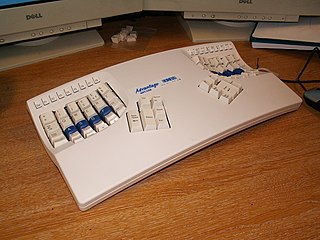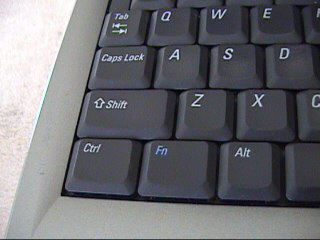
The Power Macintosh, later Power Mac, is a family of personal computers designed, manufactured, and sold by Apple Computer, Inc as the core of the Macintosh brand from March 1994 until August 2006.

The Apple IIe is the third model in the Apple II series of personal computers produced by Apple Computer. It was released as the successor to the Apple II Plus. The e in the name stands for enhanced, referring to the fact that several popular features were now built-in that were formerly only available as upgrades or add-ons in earlier models. It is notable as the first Apple II to offer built-in lower-case and 80 columns text support, as well a full 64K RAM–all while reducing the total chip count from previous models by approximately 75%.

Apple Desktop Bus (ADB) is a proprietary bit-serial peripheral bus connecting low-speed devices to computers. It was introduced on the Apple IIGS in 1986 as a way to support low-cost devices like keyboards and mice, allowing them to be connected together in a daisy chain without the need for hubs or other devices. Apple Desktop Bus was quickly introduced on later Macintosh models, on later models of NeXT computers, and saw some other third-party use as well. Like the similar PS/2 connector used in many PC-compatibles at the time, Apple Desktop Bus was rapidly replaced by USB as that system became popular in the late 1990s; the last external Apple Desktop Bus port on an Apple product was in 1999, though it remained as an internal-only bus on some Mac models into the 2000s.

The Macintosh II is a personal computer designed, manufactured, and sold by Apple Computer from March 1987 to January 1990. Based on the Motorola 68020 32-bit CPU, it is the first Macintosh supporting color graphics. When introduced, a basic system with monitor and 20 MB hard drive cost US$5,498. With a 13-inch color monitor and 8-bit display card the price was around US$7,145. This placed it in competition with workstations from Silicon Graphics, Sun Microsystems, and Hewlett-Packard.

The Apple IIc, the fourth model in the Apple II series of personal computers, is Apple Computer's first endeavor to produce a portable computer. The result was a 7.5 lb (3.4 kg) notebook-sized version of the Apple II that could be transported from place to place — a portable alternative and complement to the Apple IIe. The c in the name stood for compact, referring to the fact it was essentially a complete Apple II computer setup squeezed into a small notebook-sized housing. While sporting a built-in floppy drive and new rear peripheral expansion ports integrated onto the main logic board, it lacks the internal expansion slots and direct motherboard access of earlier Apple II models, making it a closed system like the Macintosh. However, that was the intended direction for this model — a more appliance-like machine, ready to use out of the box, requiring no technical know-how or experience to hook up and therefore attractive to first-time users.

A function key is a key on a computer or terminal keyboard that can be programmed so as to cause an operating system command interpreter or application program to perform certain actions, a form of soft key. On some keyboards/computers, function keys may have default actions, accessible on power-on.

The PowerBook Duo is a line of subnotebooks manufactured and sold by Apple Computer from 1992 until 1997 as a more compact companion to the PowerBook line. Improving upon the PowerBook 100's portability, the Duo came in seven different models. They were the Duo 210, 230, 250, 270c, 280, 280c, and 2300c, with the 210 and 230 being the earliest, and the 2300c being the final incarnation before the entire line was dropped in early 1997.
Microsoft has designed and sold a variety of ergonomic keyboards for computers. The oldest is the Microsoft Natural Keyboard, released in 1994, the company's first computer keyboard. The newest models are the Sculpt Ergonomic Keyboard (2013), the Surface Ergonomic Keyboard (2016), and the Microsoft Ergonomic Keyboard (2019).
The Command key, ⌘, formerly also known as the Apple key or open Apple key, is a modifier key present on Apple keyboards. The Command key's purpose is to allow the user to enter keyboard commands in applications and in the system. An "extended" Macintosh keyboard—the most common type—has two command keys, one on each side of the space bar; some compact keyboards have one only on the left.

Kinesis is a company based near Seattle that offers computer keyboards with ergonomic designs as alternatives to the traditional keyboard design. Most widely known among these are the contoured Advantage line, which features recessed keys in two bucket-like hollows to allow the user's fingers to reach keys with less effort. Moreover, the keys are laid out in perfect vertical rows to avoid the need for lateral movements during typing. In addition, the modifiers such as enter, alt, backspace, control, etc. are moved to a central location so they can be pressed with the stronger thumbs rather than the pinky fingers.
A menu bar is a graphical control element which contains drop-down menus.

Apple Inc. has designed and developed many external keyboard models for use with families of Apple computers, such as the Apple II, Mac, and iPad. The Magic Keyboard and Magic Keyboard with Numeric Keypad designed to be used via either Bluetooth and USB connectivity, and have integrated rechargeable batteries; The Smart Keyboard and Magic Keyboard accessories for iPads are designed to be directly attached to and powered by a host iPad. All current Apple keyboards utilize low-profile key designs, and common modifier keys.

The PowerBook 500 series is a range of Apple Macintosh PowerBook portable computers first introduced by Apple Computer with the 540c model on May 16, 1994. It was the first to have stereo speakers, a trackpad, and Ethernet networking built-in.

The Apple Adjustable Keyboard is an ergonomic keyboard introduced by Apple Computer, Inc. in 1993 for the Macintosh family of personal computers. The keyboard attaches to the computer via the Apple Desktop Bus port. The last Apple computer released compatible with this keyboard without using a USB to ADB adapter was the Power Macintosh G3, as it was the last one with the Apple Desktop Bus.

The Fn key, short form for function, is a modifier key on many keyboards, especially on laptops, used in a compact layout to combine keys which are usually kept separate. It is typically found on laptops due to their keyboard size restrictions. It is also found on many full-sized "multimedia" keyboards as the F-Lock key. It is mainly for the purpose of changing display or audio settings quickly, such as brightness, contrast, or volume, and is held down in conjunction with the appropriate key to change the settings.

The Apple IIc Plus is the sixth and final model in the Apple II series of personal computers, produced by Apple Computer. The "Plus" in the name was a reference to the additional features it offered over the original portable Apple IIc, such as greater storage capacity, increased processing speed, and a general standardization of the system components. In a notable change of direction, the Apple IIc Plus, for the most part, did not introduce new technology or any further evolutionary contributions to the Apple II series, instead merely integrating existing peripherals into the original Apple IIc design. The development of the 8-bit machine was criticized by quarters more interested in the significantly more advanced 16-bit Apple IIGS.

The Macintosh Quadra 605 is a personal computer designed, manufactured, and sold by Apple Computer from October 1993 to July 1996. The model names reflect a decision made at Apple in 1993 to follow an emerging industry trend of naming product families for their target customers – Quadra for business, LC for education, and Performa for home. Accordingly, the Performa 475 and 476 was sold in department stores and electronics stores such as Circuit City, whereas the Quadra was purchased through an authorized Apple reseller.

Apple Inc. has designed and manufactured several models of mice, trackpads and other pointing devices, primarily for use with Macintosh computers. Over the years, Apple has maintained a distinct form and function with its mice that reflect their design languages of that time. Apple's current external pointing devices are the Magic Mouse 2 and Magic Trackpad 2.

A computer keyboard is a peripheral input device modeled after the typewriter keyboard which uses an arrangement of buttons or keys to act as mechanical levers or electronic switches. Replacing early punched cards and paper tape technology, interaction via teleprinter-style keyboards have been the main input method for computers since the 1970s, supplemented by the computer mouse since the 1980s.

The power key, or power button, is a key found on many computer keyboards during the 1980s and into the early 2000s. They were introduced on the first Apple Desktop Bus keyboards in the 1980s and have been a standard feature of many Macintosh keyboards since then. They are also found on an increasing number of Microsoft Windows keyboards, sometimes supplanted with additional keys for sleep. The power key is becoming increasingly rare, as most modern personal computers using USB allow the system to be started up by pressing any key on the keyboard.

















